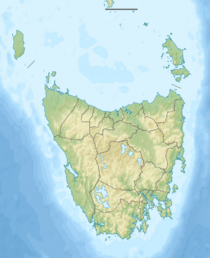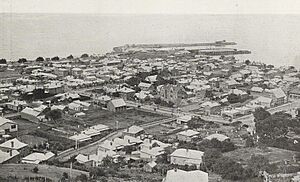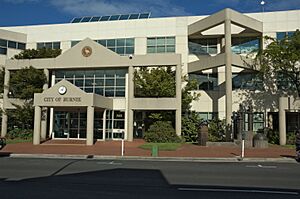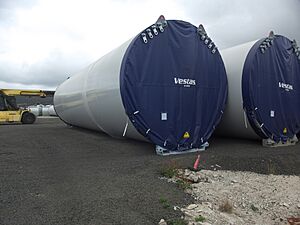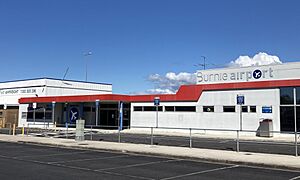Burnie facts for kids
Quick facts for kids BurnieTasmania |
|||||||||
|---|---|---|---|---|---|---|---|---|---|
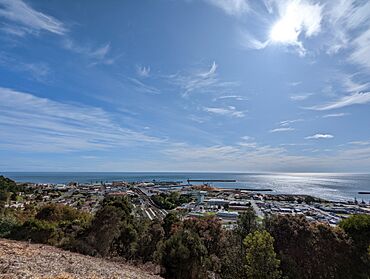
Burnie CBD and port
|
|||||||||
| Population | 19,918 (2021) | ||||||||
| Established | 1827 | ||||||||
| Gazetted | 1967 | ||||||||
| Postcode(s) | 7320 | ||||||||
| Elevation | 19 m (62 ft) | ||||||||
| Time zone | AEST (UTC+10) | ||||||||
| • Summer (DST) | AEDT (UTC+11) | ||||||||
| Location |
|
||||||||
| LGA(s) | City of Burnie | ||||||||
| State electorate(s) | Braddon | ||||||||
| Federal Division(s) | Braddon | ||||||||
|
|||||||||
Burnie (/ˈbɜːrni/ BER-nee; pirinilaplu/palawa kani: pataway) is a port city located on the north-west coast of Tasmania, Australia. It is the fourth largest city on the island, located approximately 325 kilometres (202 mi) north-west of the state capital of Hobart, 147 kilometres (91 mi) north-west of Launceston, and 47 kilometres (29 mi) west of Devonport. Founded in 1827 as Emu Bay, the township was renamed in the early 1840s after William Burnie, a director of the Van Diemen's Land Company, and proclaimed a city by Queen Elizabeth II on 26 April 1988. As of the 2021 census, Burnie has a population of 19,918, with a municipality area spanning 600 square kilometres (230 sq mi), administered by the City of Burnie.
Burnie's economy has historically been driven by heavy manufacturing, mining, forestry, and farming. Situated on the coastline of Emu Bay, the city’s fortunes are closely tied to its deep water port. An intermodal freight transport facility, the Port of Burnie handles over 5,000,000 tonnes (4,900,000 long tons; 5,500,000 short tons) of freight annually, including nearly half of Tasmania's containerised freight. As Tasmania's most north-westerly city, it provides the shortest sea lines of communication between mainland Tasmania and mainland Australia. The city is a key exporter of Tasmanian minerals, including copper, silver, gold, tin, lead, zinc, iron, tungsten, and ultra-high purity silica, alongside forestry products such as logs, pulpwood, and wood chips. The Burnie Chip Export Terminal, often referred to as the "Pyramids of Burnie", surpassed 1,500,000 tonnes (1,500,000 long tons; 1,700,000 short tons) of annual wood chip exports in 2017.
During the 1970s and 80s, Burnie faced pollution challenges linked to titanium dioxide production. From the 1990s, the city experienced significant industrial decline, with the closure of several manufacturing plants and the eventual shutdown of its pulp and paper mill. This downturn led to population decline and high unemployment, presenting economic hardships and uncertainty for the community.
In recent years, Burnie has been positioning itself as a future leader in Tasmania’s renewable energy sector. By 2024, the city is set to be a key player in the proposed North West Renewable Energy Zone (REZ), a project designed to foster investment in large-scale wind and solar energy developments. The Marinus Link, a high-voltage direct current submarine power cable, is also planned to connect Tasmania’s renewable energy supply to mainland Australia, potentially generating 1,400 local jobs and bringing an estimated $3 billion in economic investment. Current proposals for the region include the Guildford and Hellyer Wind Farms, as well as Australia’s first synthetic electrofuel facility. Other growing sectors in Burnie include education, healthcare, and logistics, contributing to its economic diversification.
Contents
History
Early history (1827 - 1875)
Burnie's history is closely tied to the establishment of the Van Diemen's Land Company (VDL Company) in the early 19th century. In 1824, a group of wool merchants, bankers, investors, and woollen mill owners gathered in London to explore the idea of creating a land company in Van Diemen's Land, following the model of the Australian Agricultural Company in the Colony of New South Wales. With backing from William Sorell, a former lieutenant governor, and Edward Curr, who had recently returned from the colony, they established the VDL Company, with William Burnie its inaugural Governor of Company. They applied to Lord Bathurst for a grant of 500,000 acres (200,000 ha), while Bathurst approved a smaller allotment of 250,000 acres (100,000 ha), the company received a Royal Charter in 1825, giving it broad authority to cultivate land, and build housing and wharves to support colonial development within a 250,000-acre (100,000 ha) area in North-West Tasmania.
Oakleigh Park, close to Burnie’s business centre, is the birthplace of Burnie and the cradle of the northwest coast. In 1827, chief surveyor of the VDL Company, Henry Hellyer, camped beside Whalebone Creek there. With approval from the Company’s chief agent, Edward Curr, Hellyer selected Emu Bay as the port to service the Company’s inland holdings at Hampshire and Surrey Hills, located around 50 kilometres (31 mi) inland. A year later, government surveyor John Helder Wedge recommended Emu Bay be reserved as an official township due to its strategic value for shipping. Still, the VDL Company was already occupying the area. At that time, the Emu Bay settlement consisted of a store, a small jetty, a sawpit, and a few huts. Hellyer also cut the Old Surrey Road through dense rainforest, establishing the first road on the North West Coast, starting from the South Burnie beach.
However, Burnie’s settlement wasn’t peaceful. Between 1828 and 1832, Tarenorerer, a Tommeginne woman who had escaped from sealers, became the leader of the Emu Bay people (Plairhekehillerplue). She led a resistance against settlers during the Black War, attacking VDL Company employees until she was eventually captured. Alexander Goldie, the first superintendent of the Company's land assets around Emu Bay, led armed attacks against the Plairhekehillerplue clan. In 1828, Goldie and his men massacred several people inland from the settlement and in August 1829 they murdered a native woman at Emu Bay by shooting her and cutting her neck with an axe. Goldie then kidnapped the woman's five-year-old daughter and another woman. After an investigation, Goldie resigned from his position. Meanwhile, the VDL Company faced difficulties. By 1833, sheep farming at Surrey Hills had failed due to cold conditions, resulting in the near abandonment of the area.
Throughout the 1840s, the VDL Company began leasing bush blocks to tenant farmers, although Burnie’s growth remained slow. In 1843, the town was surveyed by Nathaniel Kentish and renamed after William Burnie, then serving as on of eighteen directors of the VDL Company. By 1853, Burnie had a population of approximately 200, with basic services such as a doctor and clergyman located in Port Sorell, and a lawyer and banker in Launceston. Transport and communication systems were rudimentary at this time, with no metal roads or established wharves. Nevertheless, the first official birth registrations in Burnie began that year.
Burnie’s first school was opened in 1862 by Mrs. Mary Morris in West Burnie, followed by the construction of the first government school on a rocky hill off Wilmot Street. In 1875, the VDL Company established its headquarters in Oakleigh (now Oakleigh Park), which remained in Burnie until the early 1950s. Burnie became the base for developing the region’s road and rail infrastructure.
Mineral boom and industrial development (1876 - 1939)
In the late 1870s, modern communication systems arrived, with the telegraph and telephone reaching Burnie. A horse-drawn tramway on wooden rails was established to connect Burnie to Waratah. The VDL Company later upgraded this tramway to iron and steam, facilitating the transport of tin from the Mount Bischoff mine, which commenced Burnie’s role as the west coast’s export gateway for minerals. By the 1880s, Burnie's fortunes had dramatically improved as west coast mineral deposits were discovered. The Emu Bay Railway Company extended the railway to Zeehan by 1900, propelling the town's population to over 1,500.
During this time, Burnie’s business district rapidly grew, thanks to improved port facilities and the expansion of the town's infrastructure. By 1900, T. Wiseman's motor coach service was operating between Burnie and Stanley, reflecting Burnie's growing importance as a regional transport hub.
A major turning point occurred in 1936 with the construction of the Associated Pulp and Paper Mill (APPM) in South Burnie. By 1939, the mill produced 15,000 tonnes (15,000 long tons; 17,000 short tons) of fine paper annually, the first time in the world that paper was made entirely from eucalypt pulp. This industrial expansion caused a surge in employment and population growth, setting Burnie on the path to becoming an industrial powerhouse.
Post-war boom and industrial expansion (1940 - 1980s)
The post-war era saw Burnie become synonymous with industry. Throughout the 1950s and 1960s, APPM expanded its workforce to around 3,500 employees, while other secondary industries, including pigment producer Tioxide and North West Acid, were established. This industrial boom led to Burnie’s official recognition as a city in 1988. At its peak in the mid 1980s, Burnie had a population exceeding 20,500, thriving as a bustling industrial centre.
However, the town's success came with environmental consequences. During the 1970s, the production of titanium dioxide by Tioxide led to heavy pollution, turning the sea rust-red from effluent. Burnie also developed a reputation as one of Tasmania’s most polluted towns, a situation highlighted by the Australian band Midnight Oil in their song “Burnie,” which criticised the town’s environmental issues.
Challenges and reinvention (1980s - present)
The rationalisation of Australian industry during the 1980s and 1990s dealt a severe blow to Burnie. APPM downgraded its operations and eventually closed the pulp mill in 2010, leading to significant job losses. Other closures followed, including the Caterpillar mining machinery factory, triggering a period of economic uncertainty for the town.
Despite these setbacks leading to unstable population and inconsistent investment, Burnie began to reinvent itself in the 1990s. The Lion cheese-making factory remained a major employer, and efforts were made to diversify the city’s economy. By the 2000s, Burnie shifted toward tourism and the arts. It became known for its clean beaches, inclusion on the annual cruise ship itinerary, and its growing community of artists and makers. In 2016, Elphinstone Group, previously a designer and manufacturer for Caterpillar equipment in Australia, relaunched its original brand and developed the Haulmax 3900 series off-highway haul truck. The company continues to be a major local employer, with a workforce of 2,500 people. Today, Burnie positions itself as the gateway to Tasmania’s northwest, including the Tarkine forest, and as a hub for new industries and outdoor recreation.
Demographics
| Historical population | ||
|---|---|---|
| Year | Pop. | ±% |
| 1853 | 200 | — |
| 1933 | 6,659 | +3229.5% |
| 1942 | 9,150 | +37.4% |
| 1947 | 10,080 | +10.2% |
| 1953 | 11,500 | +14.1% |
| 1972 | 19,954 | +73.5% |
| 1973 | 20,300 | +1.7% |
| 1986 | 20,585 | +1.4% |
| 1991 | 20,482 | −0.5% |
| 2001 | 18,108 | −11.6% |
| 2006 | 19,057 | +5.2% |
| 2011 | 19,329 | +1.4% |
| 2016 | 18,895 | −2.2% |
| 2021 | 19,918 | +5.4% |
| 2023 | 20,463 | +2.7% |
| Source: Australian Bureau of Statistics census data. | ||
Burnie had a population of 19,918 according to the 2021 census, making it one of the key urban centres in North West Tasmania. Historically, Burnie has experienced periods of rapid growth, particularly in the late 19th and mid-20th centuries, followed by fluctuations in more recent decades, with some signs of stabilisation and recovery in the 21st century. While 2023 State Government growth estimates are positive, Burnie is yet to recover to population levels experienced in the mid 1980s. At the 2021 census, Burnie's population is slightly older compared to national averages, with a significant portion (around 19%) aged 65 and over. This reflects a trend of ageing populations common in regional areas.
Economically, Burnie is a working-class hub with a median household income of $1,148 per week, lower than the national median of $1,746. The city's unemployment rate was around 8.1%, higher than the national rate of 5.1%. These figures suggest some economic challenges in the area, although Burnie's role as a regional port and industrial centre still gives it economic significance within Tasmania.
Burnie also has a notable Indigenous population, with around 8.5% of residents identifying as First Nations people or Torres Strait Islander, higher than the national figure of 3.2%. This reflects Tasmania's broader demographics where Indigenous representation is above the national average. The majority of residents (84.4%) were born in Australia, with smaller populations from England (2.4%), New Zealand (0.9%), India (0.8%), Nepal and the Philippines (0.4%), and mainland China (0.3%). English is the dominant language, spoken by 90.2% of residents at home, while 5.9% of households speak a non-English language.
In terms of religion, 53.4% of Burnie's population reported no religious affiliation, while 38.8% identified with a Christian denomination, including 11.4% as Catholic and 11.2% as Anglican. Other religious groups include Hinduism (0.9%), Buddhism (0.7%), Islam (0.6%), and Sikhism (0.2%).
Climate
Burnie has a oceanic climate (Köppen: Cfb), with very mild, relatively dry summers and cool, rainy winters. Seasonal variation is low due to moderation from the Bass Strait. Average maxima vary from 21.3 °C (70.3 °F) in February to 12.8 °C (55.0 °F) in July while average minima fluctuate between 13.3 °C (55.9 °F) in February and 6.0 °C (42.8 °F) in July. Mean average annual precipitation is moderate, 947.4 mm (37.30 in) spread between 158.0 precipitation days, and is concentrated in winter. The town is not very sunny, with 141.1 cloudy days and only 51.7 clear days per annum. Extreme temperatures have ranged from −2.0 °C (28.4 °F) on 14 July 1967 to 33.8 °C (92.8 °F) on 31 January 2009. Sunshine data was sourced from Elliott, a rural locality 14.3 kilometres (8.9 mi) west-northwest of Burnie.
| Climate data for Burnie (41º04'12"S, 145º56'24"E, 8 m AMSL) (1944-2018 normals and extremes, sun 1965-1993) | |||||||||||||
|---|---|---|---|---|---|---|---|---|---|---|---|---|---|
| Month | Jan | Feb | Mar | Apr | May | Jun | Jul | Aug | Sep | Oct | Nov | Dec | Year |
| Record high °C (°F) | 33.8 (92.8) |
31.0 (87.8) |
28.9 (84.0) |
26.2 (79.2) |
24.0 (75.2) |
18.9 (66.0) |
18.3 (64.9) |
18.9 (66.0) |
22.4 (72.3) |
27.6 (81.7) |
31.5 (88.7) |
31.2 (88.2) |
33.8 (92.8) |
| Mean daily maximum °C (°F) | 21.1 (70.0) |
21.3 (70.3) |
20.1 (68.2) |
17.8 (64.0) |
15.3 (59.5) |
13.5 (56.3) |
12.8 (55.0) |
13.2 (55.8) |
14.4 (57.9) |
16.0 (60.8) |
17.9 (64.2) |
19.5 (67.1) |
16.9 (62.4) |
| Mean daily minimum °C (°F) | 12.7 (54.9) |
13.3 (55.9) |
12.1 (53.8) |
10.1 (50.2) |
8.4 (47.1) |
6.8 (44.2) |
6.0 (42.8) |
6.1 (43.0) |
6.8 (44.2) |
8.1 (46.6) |
9.8 (49.6) |
11.2 (52.2) |
9.3 (48.7) |
| Record low °C (°F) | 2.8 (37.0) |
3.9 (39.0) |
3.5 (38.3) |
0.5 (32.9) |
0.0 (32.0) |
−1.1 (30.0) |
−1.7 (28.9) |
−2.0 (28.4) |
0.0 (32.0) |
−0.8 (30.6) |
1.0 (33.8) |
2.9 (37.2) |
−2.0 (28.4) |
| Average precipitation mm (inches) | 44.9 (1.77) |
43.2 (1.70) |
51.6 (2.03) |
73.0 (2.87) |
94.5 (3.72) |
101.4 (3.99) |
123.8 (4.87) |
110.2 (4.34) |
88.7 (3.49) |
84.4 (3.32) |
68.5 (2.70) |
63.2 (2.49) |
947.4 (37.30) |
| Average precipitation days (≥ 0.2 mm) | 9.3 | 8.1 | 9.8 | 11.5 | 14.7 | 14.8 | 17.8 | 17.9 | 15.8 | 14.7 | 12.6 | 11.0 | 158 |
| Average afternoon relative humidity (%) | 62 | 64 | 63 | 66 | 71 | 72 | 73 | 71 | 69 | 65 | 64 | 62 | 67 |
| Average dew point °C (°F) | 11.6 (52.9) |
12.6 (54.7) |
11.4 (52.5) |
10.0 (50.0) |
8.9 (48.0) |
7.3 (45.1) |
6.8 (44.2) |
6.8 (44.2) |
7.2 (45.0) |
7.7 (45.9) |
9.3 (48.7) |
10.3 (50.5) |
9.2 (48.5) |
| Mean monthly sunshine hours | 254.2 | 217.5 | 192.2 | 159.0 | 127.1 | 120.0 | 127.1 | 139.5 | 159.0 | 210.8 | 219.0 | 232.5 | 2,157.9 |
| Percent possible sunshine | 56 | 56 | 50 | 48 | 42 | 43 | 43 | 43 | 45 | 51 | 51 | 50 | 48 |
| Source: Bureau of Meteorology (1944-2018 normals and extremes, sun 1965-1993) | |||||||||||||
Governance
| Mayor of Burnie | |
|---|---|
|
Incumbent
Teeny Brumby since 26 October 2022 |
|
| Style | Councillor |
| Member of | Burnie City Council |
| Formation | 1898 |
| First holder | Captain William Jones |
There are nine councillors that govern the Burnie City Council, each serving four-year terms. Teeny Brumby was elected mayor of the City of Burnie in 2022. The council oversees Burnie's infrastructure, community services, and local regulations. The council also plays a key role in fostering the arts and supporting projects like the Burnie Arts and Function Centre.
Burnie’s political landscape is shaped by a mix of conservative and independent influences, reflecting broader trends in Tasmania’s evolving political dynamics. At the state level, Burnie falls within the Tasmanian House of Assembly’s electoral division of Braddon, a multi-member electorate that includes both Labor and Liberal members.
Nationally, Burnie is located in the federal electorate of Braddon, currently represented by Gavin Pearce of the Liberal Party of Australia. Braddon has traditionally been a marginal seat, with representation often alternating between the Labor and Liberal parties in federal elections.
In the Australian Senate, Tasmania is represented by six senators, including Jacquie Lambie, the leader and founder of the Jacqui Lambie Network (JLN). Lambie, a well-known political figure, resides in Burnie, where she maintains significant support.
Economy
Burnie's economy has long been shaped by its key industries of heavy manufacturing, forestry, and farming, with the Port of Burnie playing a central role. Historically, the port became the main hub for exporting minerals from Tasmania's west coast after the Emu Bay Railway opened in 1897, cementing Burnie’s status as an industrial centre. The railway and the port served as the backbone of Burnie's early industry, driving the city’s growth and development.
Over time, the agriculture industry, once prominent in the region, shifted focus following the handover of the Surrey Hills and Hampshire Hills lots. This transition marked the rise of the forestry sector, which began to dominate Burnie’s economy in the 20th century. Forestry played a pivotal role in the city’s development, particularly with the establishment of Associated Pulp and Paper Mills (APPM) in 1938. The founding of the pulp and paper mill marked a significant industrial milestone for Burnie, positioning it as a key player in Australia’s paper production. The city also became a centre for woodchip exports, with the construction of the woodchip terminal further bolstering its role in the forestry supply chain.
However, the decline of the paper industry signaled a major economic shift for Burnie. The closure of the Burnie Paper Mill in 2010, after a failed attempt to secure a buyer, marked the end of an era for one of the city's most iconic industries. Despite the mill’s closure, forestry remains an important part of Burnie's economy, with woodchip exports continuing through the Burnie Chip Export Terminal, colloquially known as the "Pyramids of Burnie". While heavy manufacturing and forestry continue to be significant, Burnie has sought to diversify its economy in recent years, exploring opportunities in renewable energy, tourism, and education.
Emerging industry
Marinus Link
The Marinus Link project is expected to further boost Burnie's economy. This $3.5b (2021) project will connect Heybridge to Waratah Bay, Victoria via 255 kilometres (158 mi) of high voltage direct current submarine power cable, supplying renewable energy to the Australian mainland. Supporting infrastructure, including the North West Transmission Developments, will reinforce Burnie’s position as a renewable energy hub. The project is expected to generate 1,400 local jobs and contribute $3b in direct economic investment while supplying enough electricity to power 1.5 million homes and significantly reducing carbon emissions. Construction is expected to begin in 2026 and be completed by 2030.
E-fuels facility
Burnie was chosen as the site for Australia’s first commercial-scale e-fuels facility due to Tasmania's 100% renewables grid, its deep water port facilities and its proximity to Forico’s Surrey Hills plantation. This nationally significant, $1b facility will produce up to 100,000,000 litres (22,000,000 imp gal; 26,000,000 US gal) of carbon-neutral e-fuels annually, helping to decarbonise industries that still rely on liquid fuels, such as aviation, shipping, and heavy transport. By using renewable energy to power its processes, the plant aims to reduce global carbon emissions by approximately 260,000 tonnes (260,000 long tons; 290,000 short tons) per year, equivalent to decarbonising 52,000 cars. Designed by France’s Technip Energies NV, the facility is set to be active by 2028 and create 200 permanent jobs.
Wind farms
Several wind farm projects proposed in the surrounding region, notably the Guildford and Hellyer Wind Farms, located south of Burnie, are part of Tasmania's broader push to increase its renewable energy capacity. These wind farms are expected to generate significant power, contributing to the state's goal of 200% renewable energy by 2040.
Cultural and educational institutions
Burnie has long been a hub for cultural, educational, and health services in the northwest region of Tasmania. At the heart of its cultural precinct is the Burnie Arts and Function Centre, which replaced the old Burnie Theatre in 1965. Originally known as the Civic Centre, this multi-functional venue is an important space for the community, hosting performances, events, and exhibitions that attract visitors from across the region. The centre is also home to one of Australia's largest regional art galleries, which opened in 1978, and the Burnie Regional Museum, designed by architects Leith and Bartlett, which houses the historic Federation Street—the first indoor streetscape of its kind in the country. In 2021, plans for a new $18m North West Museum and Art Gallery, designed by Terrior Architects, were abandoned. Instead, the focus shifted toward enhancing and consolidating the region’s existing cultural facilities.
In addition to these cultural landmarks, Burnie provides essential health services through the North West Regional Hospital, located on Brickport Road. As the third-largest hospital in Tasmania, it offers a range of in-patient and out-patient services, including general medicine, surgery, orthopaedics, psychiatry, and paediatrics, playing a vital role in the well-being of the wider community.
Burnie is also home to key educational institutions, including the Cradle Coast campus of the University of Tasmania, where the Cuthbertson Research Laboratories are part of the Tasmanian Institute of Agricultural Research. The town also hosts campuses for the Tasmanian Polytechnic and Tasmanian Academy, ensuring a range of learning opportunities for students in the region. Alongside these, Burnie boasts numerous sporting and social organisations that contribute to the vibrant community life.
Transport
Burnie Airport is located in the adjacent town of Wynyard, a 20-minute drive from the central business district.
Burnie Port, operated by TasPorts, is Tasmania's largest general cargo port. It is the nearest Tasmanian port to Melbourne and Mainland Australia. The 1969 built shiploader was upgraded in 2024 doubling the ports capacity.
Burnie is served by TasRail services on the Melba and Western lines, Burnie was previously the terminus of the former Emu Bay Railway. Burnie had passenger rail services including the Tasman Limited until the mid-1970s. The rise of road transport and declining demand led to the discontinuation of passenger services.
Burnie is connected with Devonport via the four-lane Bass Highway and a rail link used for freight purposes. Burnie is also connected to the West Coast by the Murchison Highway.
Metro Tasmania operate local bus services around the city and its suburbs. Redline Coaches operate a service to Smithton. Tassielink Transit operate services to Strahan.
Coastal pathway
In October 2024, a 13 kilometre coastal pathway between Burnie and Wynyard on the former Western railway line opened.
Suburbs
The city of Burnie consists of a number of small suburbs including Parklands, Park Grove, Shorewell Park, Acton, Montello, Hillcrest, Terrylands, Upper Burnie, Romaine, Havenview, Emu Heights, South Burnie and Wivenhoe.
Sport
Australian rules football is popular in Burnie. The city's team is the Burnie Dockers Football Club in the Tasmanian State League. Their ground is West Park Oval.
Rugby union is also played in Burnie. The local club is the Burnie Rugby Union Club. They are the current Tasmanian Rugby Union Statewide Division Two Premiers and were promoted to the Statewide First Division for the 2008 season.
Soccer is also represented in Burnie, with Burnie United FC having four teams compete in the northern premier league; the women's team, under 18 team, reserve team and division one team. They also have youth sides in the under 14 and under 16 competitions. Their ground is located in Montello, Tasmania.
Burnie hosts an ATP Challenger Tour tennis event, the Burnie International, during the week following the Australian Open.
Athletics events include the annual Burnie Gift and Burnie Ten.
Archery is also represented in Burnie, with Burnie Bowmen Archery Club. They were founded in 1958 and have influenced the development of archery along the northwest coast of Tasmania. Its first target championship was held in 1959. In 1972 Burnie Bowmen Archery Club was given the honor of holding the first national championships to be held outside of a capital city. In 2017 Burnie Bowmen Archery club hosted Archery for the XVI Australian Masters Games. In 2020 and 2021 they were to host the National Youth Archery Championships and National Archery Championships, but due to COVID-19 these events were cancelled. Presently, Target and Clout shoots are conducted at Parklands High School Oval in Romaine, Burnie. Indoor is conducted at the Upper Burnie Memorial Hall. Field is conducted at the Blythe Scout Camp at Heybridge.
Media
The Advocate newspaper was established in 1890 servicing the North West region. The mailroom is located in Burnie whilst the local press operations ceased in mid-2008 and were relocated to Launceston.
Burnie has access to the ABC, SBS, WIN and Southern Cross television stations as well as all new free to air television stations.
There are two commercial radio stations, 7BU at 100.9 MHz on the FM band and Sea FM on 101.7 on the FM band. Many Melbourne radio stations can be received in Burnie.
Notable people
- Country music singer Jean Stafford OAM was a resident of Burnie in the 1960s and early 1970s when she was a young wife and mother at the beginning of her career. Her family still reside in the area.
- Zima Anderson – actress in Neighbours who played Roxy Willis
- Taran Armstrong – basketball player
- Cameron Baird – Australian soldier, posthumously awarded the VC for actions in Afghanistan
- Jamie Cox – cricketer
- Josh Earl – comedian and former host of Spicks and Specks
- Dale Elphinstone – founder of Elphinstone Group and Tasmania's wealthiest person as of 2019
- Hannah Gadsby - Comedian
- Brendon Gale – AFL player Richmond Football Club
- David Guest – Australian field hockey player. 2008 Olympic bronze medalist
- Justin Heazlewood – Australian songwriter, author, actor and humorist also known as The Bedroom Philosopher
- Eddie Jones – current head coach of the Australian Wallabies National Rugby Team and former coach of the English and Japanese rugby union football teams.
- Matthew Knight – basketball player, three-time NBL champion (2014, 2016, 2017)
- Jon Kudelka - cartoonist
- Jacqui Lambie – Senator for Tasmania – Jacqui Lambie Network
- Marcus Marshall – Australian racing driver
- Brody Mihocek – AFL player-Collingwood Football Club
- Vicki O'Halloran – Administrator of the Northern Territory
- Eli Templeton – AFL player-St Kilda Football Club
- Lachie Weller – AFL player-Fremantle Football Club and Gold Coast Suns
- Maverick Weller – AFL player-Gold Coast Suns and St Kilda Football Club
- Shaun Young – cricketer
See also
 In Spanish: Burnie para niños
In Spanish: Burnie para niños


